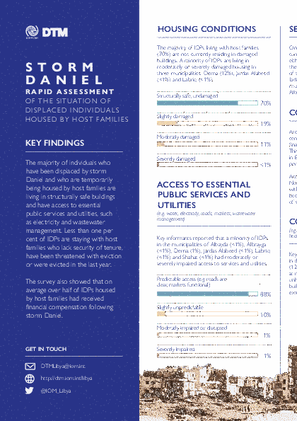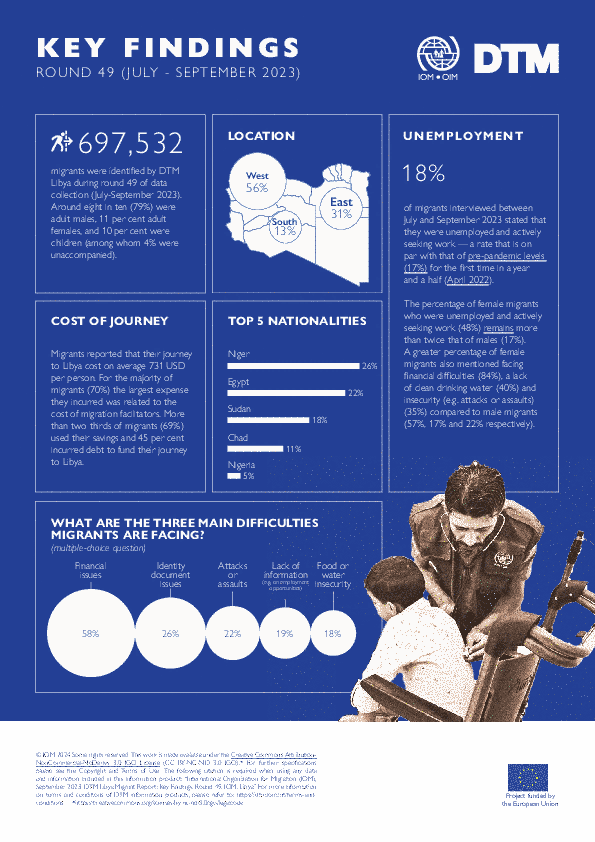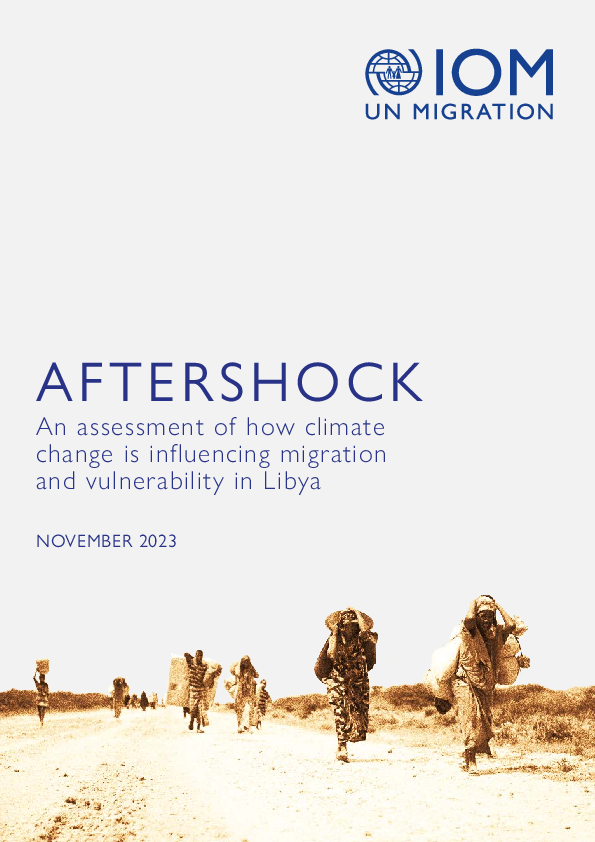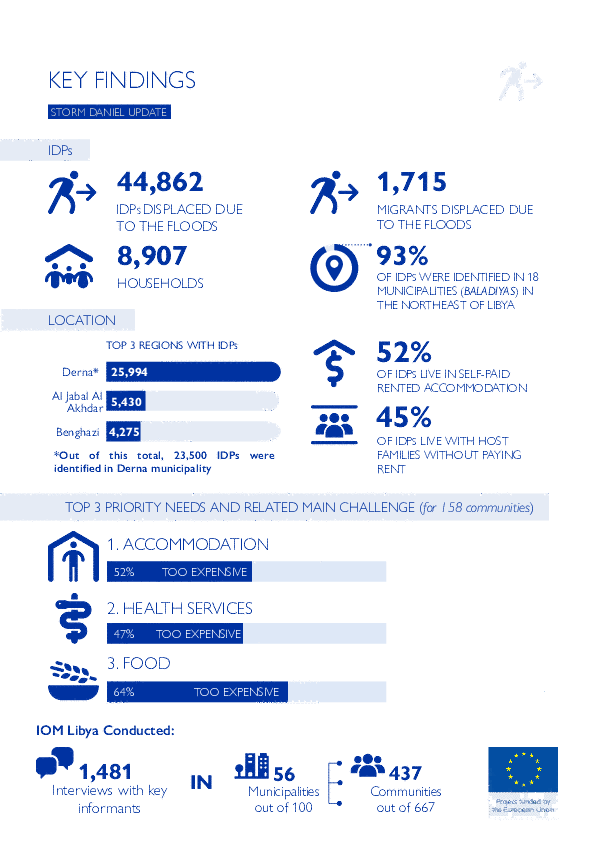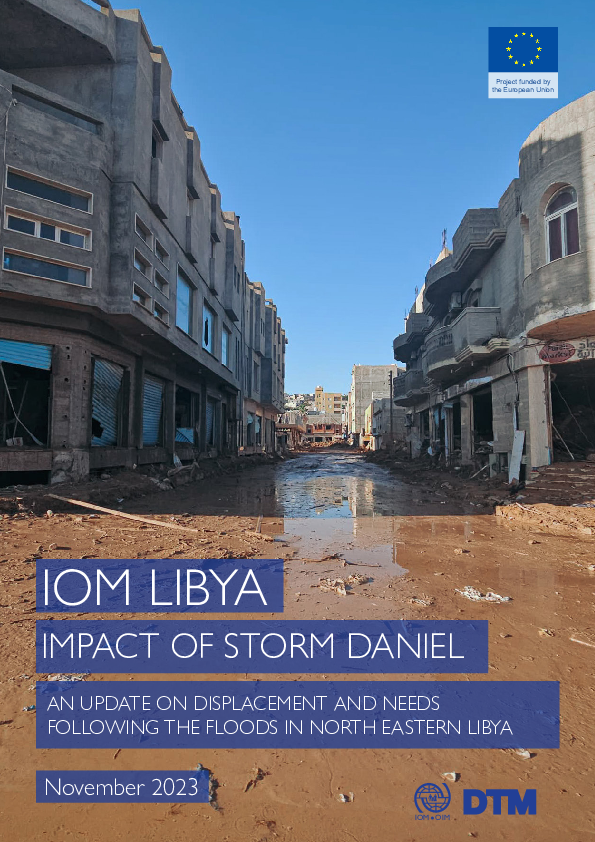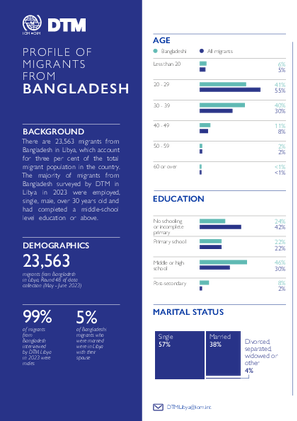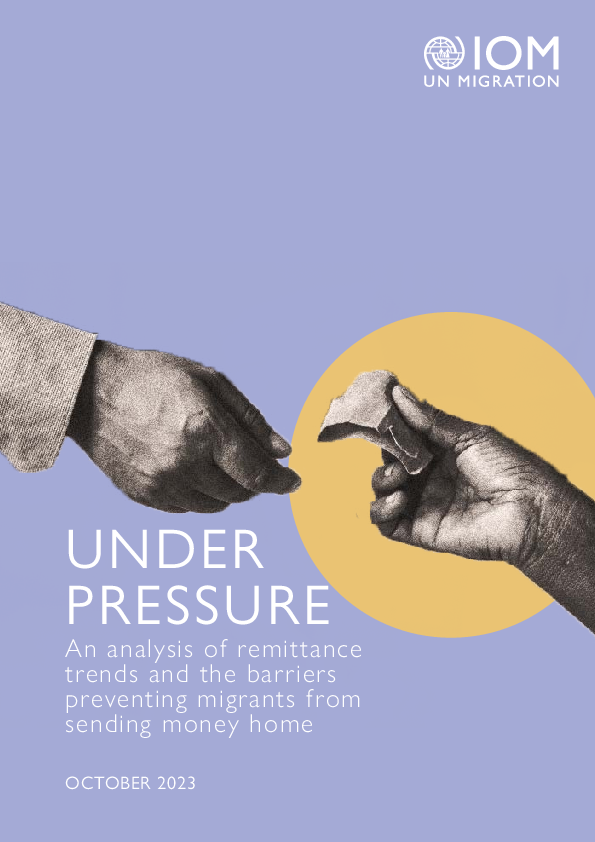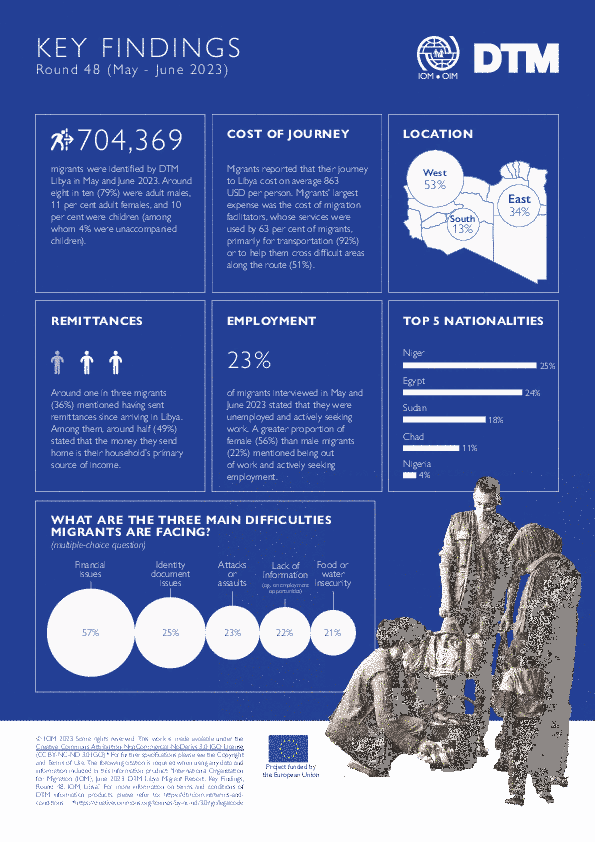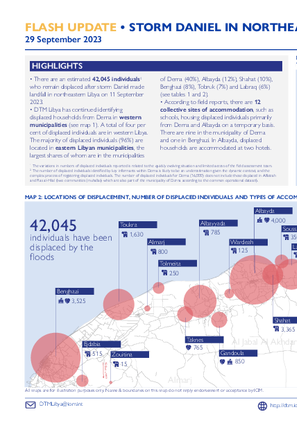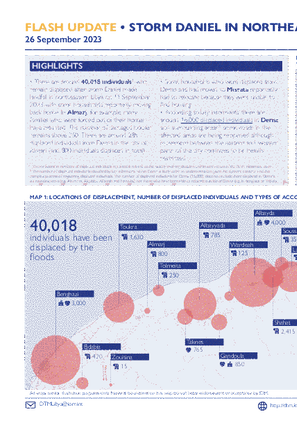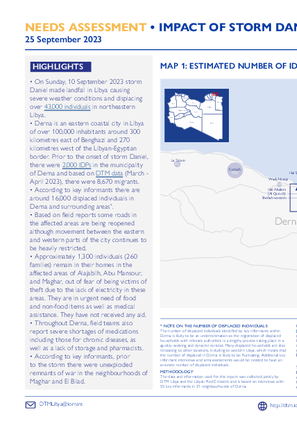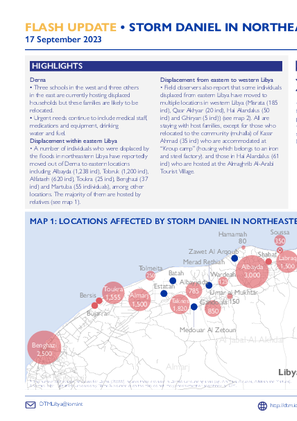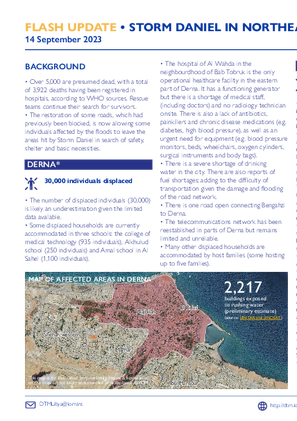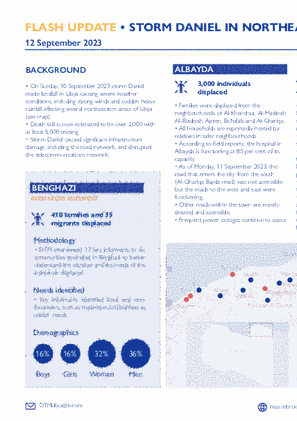-
Countries
-
Data and Analysis
-
Special Focus
-
Crisis Responses
Libya
About Libya
Libya is a geographically vast country with several regions that are difficult to access. In order to understand the full scope of humanitarian assistance that is needed throughout the country, IOM established the Displacement Tracking Matrix (DTM) programme in 2016 in order to provide a common operating picture concerning the movement of populations in Libya, allowing humanitarian actors to provide timely assistance to those in need. Following the escalation of conflict and insecurity in 2014, the security situation has remained volatile since with fluctuations in the intensity of localized clashes. Congruently, conflict has caused new displacements, often in areas ill-equipped to accommodate large population movements while also negatively impacting the large migrant population residing and transiting through Libya. More recently, the capital Tripoli was heavily affected by displacement waves in September 2018 and April 2019.
DTM’s mobility tracking and flow monitoring activities identified many migrants in-country to be in need of various forms of assistance. Libya’s geographic location, resources and work opportunities has made it both a country of destination and transit for migrants for many years. Despite the deterioration of the security situation since 2011 migrants continue coming to and transiting through Libya, the majority from Sub-Saharan and North African countries.
In this complex operating environment, DTM Libya has been providing a common operating picture concerning the movement of populations in Libya since 2016, allowing humanitarian actors to provide timely assistance to those in need. Through its mobility tracking, flow monitoring and needs assessment activities, DTM Libya has established itself as data hub for quantitative data on migratory flows to and within Libya, migrant presence in Libya disaggregated by nationality and area, as well as humanitarian needs of migrants, internally displaced population and returnees. All activities are implemented through periodical bi-monthly data collection cycles, allowing trend analysis over time to provide evidence-base for both policy-level discussions and to guide humanitarian action.
In order to facilitate humanitarian interventions, DTM works closely with IOM’s other programmes through referring identified populations in need of assistance at flow monitoring points to IOM’s Direct Assistance, Health, Voluntary Humanitarian Return (VHR), Protection and Migrant Rapid Response Mechanism (MRRM) programmes. Furthermore, DTM Libya supports other humanitarian partners through providing emergency tracking updates in case of sudden population movements as well as facilitating humanitarian assessments for the Rapid Response Mechanism (RRM) jointly implemented by IOM, UNICEF, WFP and UNFPA.
For more information on IOM's activities in Libya, please visit the IOM Libya country office website.
Contact
DTM Libya
DTMLibya@iom.int
Current Donors
- EUTF
Libya — Solutions and Mobility Index Report (January 2024)
In consideration of its Internal Displacement Strategy, IOM developed this Solutions and Mobility Index (SMI) Report to further support with data initiatives around fragility, solutions and mobility. This report provides an assessment of stability in municipalities, focusing on
Libya — Profile of Sudanese Migrants in Libya (March 2024)
This profile provides information on the situation and vulnerabilities of Sudanese migrants in Libya, including those having arrived after the onset of conflict in mid-April 2023 and provides an update to a brief published in
Migrant Report Key Findings 50 (October - December 2023)
This infographic presents the key findings of Round 50 of the mobility tracking and flow monitoring components of the Displacement Tracking Matrix (DTM) programme in Libya.
Libya — Migrant Report 50 (October - December 2023)
IOM Libya’s Displacement Tracking Matrix (DTM) programme identified a total of 706,509 migrants from 45 nationalities in the 100 Libyan municipalities during round 50 of data collection (October - December 2023). The number of migrants in Libya increased slightly compared to the previous round of
Storm Daniel Rapid Assessment of the Situation of Displaced Individuals Housed by Host Families
The information included in this report is based on 56 key informant interviews which were conducted between 31 December 2023 and 05 January 2024 over the phone and in person.
Libya — Migrant Report 49 (July - September 2023)
IOM Libya’s Displacement Tracking Matrix (DTM) programme identified a total of 697,532 migrants from over 45 nationalities in the 100 Libyan municipalities during round 49 of data collection (July - September 2023).
Migrant Report Key Findings 49 (July - September 2023)
This infographic presents the key findings of Round 49 of the mobility tracking and flow monitoring components of the Displacement Tracking Matrix (DTM) programme in Libya.
Aftershock: An assessment of how climate change is influencing migration and vulnerability in Libya (November 2023)
This study is based on data collected through interviews with 3,418 migrants held in September and October 2023 in Libya. It shows how climate change acts as a threat multiplier, exacerbating the vulnerabilities of migrants in their countries of origin and in Libya.
Libya — Impact of Storm Daniel: Displacement and Needs Update: Derna Municipality
On 10 September 2023 Storm Daniel hit northeastern Libya, leading to substantial rainfall and sudden floods in the coastal areas and cities. The subsequent collapse of the Mansour and Derna dams severely compounded damages across Derna municipality.
Libya — Impact of Storm Daniel: Displacement and Needs Key Findings Report (November 2023)
This infographic presents the key findings from the Impact of Storm Daniel: An Update on Displacement and Needs Report. The data used in the report is from the mobility tracking component of the Displacement Tracking Matrix (DTM) programme in Libya.
Libya — Impact of Storm Daniel: An Update on Displacement and Needs (November 2023)
This publication presents DTM Libya’s analysis of the displacement situation in north eastern and west Libya following the impacts of Storm Daniel which made landfall in September 2023.
Libya — Migrant Profiles (November 2023)
This document showcases the profiles of migrants from Bangladesh, Burkina Faso, Chad, Egypt, Ghana, Mali, Niger, Nigeria, Sudan and Senegal.
Nov 13 2023
Libya — Migrant Profiles (November 2023)
Under Pressure: An analysis of remittance trends and the barriers preventing migrants from sending money home (October 2023)
This study highlights some of the opportunities and challenges related to remittances, including the trends and patterns of earning, sending and using remittances as well as the barriers migrants face in sending money home.
Migrant Report Key Findings 48 (May - June 2023)
This infographic presents the key findings of Round 48 of the mobility tracking component of the Displacement Tracking Matrix (DTM) programme in Libya.
Oct 31 2023
Migrant Report Key Findings 48 (May - June 2023)
Libya — Migrant Report 48 (May—June 2023)
IOM Libya’s Displacement Tracking Matrix (DTM) programme identified a total of 704,369 migrants from over 43 nationalities in the 100 Libyan municipalities during round 48 of data collection (May - June 2023).
Oct 31 2023
Libya — Migrant Report 48 (May—June 2023)
Libya — Detention Centre Profile Generator (September 2023)
Detention Centre Profiling is a component of IOM Libya’s Displacement Matrix programme. It is a data oriented tool that routinely provides specific sex and age demographic data and key sectorial information on individuals held in Libya’s detention centres on the date of assessment.
Libya — Storm Daniel Flash Update 8 (13 October 2023)
There are an estimated 43,421 individuals who remain displaced after storm Daniel made landfall in northeastern Libya on 11 September 2023. Displaced households from Derna have continued relocating to western municipalities (see map 1).
Libya — Storm Daniel Flash Update 7 (30 September 2023)
There are an estimated 42,045 individuals who remain displaced after storm Daniel made landfall in northeastern Libya on 11 September 2023. DTM Libya has continued identifying displaced households from Derna in western municipalities (see map 1).
Libya — Storm Daniel Flash Update 6 (26 September 2023)
There are around 40,018 individuals who remain displaced after storm Daniel made landfall in northeastern Libya on 11 September 2023 with some households reportedly moving back home. In Almarj, for example, many families who were forced out of their homes have returned.
Libya — Impact of Storm Daniel on Derna: Needs Assessment Report (25 September 2023)
This report provides an overview of the situation and the main needs of the displaced population and the host community in Derna and surrounding areas. HIGHLIGHTS
Libya — Storm Daniel Flash update 3 (14 September 2023)
Over 5,000 are presumed dead, with a total of 3,922 deaths having been registered in hospitals, according to WHO sources. Rescue teams continue their search for survivors.
Libya — Storm Daniel Flash update 2 (13 September 2023)
On Sunday, 10 September 2023 storm Daniel made landfall in Libya causing severe weather conditions, including strong winds and sudden heavy rainfall affecting several northeastern areas of Libya (see map). Death toll is now estimated to be over 2,000 with at least 5,000 missing.
Pagination
Libya - Migrants Baseline Assessment Round 50
2023-12-31
<p>Libya Migrants baseline assessment</p>
Libya - Storm Daniel Update: IDPs Baseline Assessment
2023-10-31
<p>A baseline assessment is a sub-component of mobility tracking. It aims to collect data on IDP, migrant or returnee population presence in a defined administrative area of the country. This dataset contains information regarding areas in Libya that experienced new displacements in the…
Libya - Migrants Baseline Assessment Round 48
2023-06-30
A baseline assessment is a sub-component of mobility tracking. It aims to collect data on IDP, migrant or returnee population presence in a defined administrative area of the country.
Libya - Migrants Baseline Assessment Round 47
2023-04-30
A baseline assessment is a sub-component of mobility tracking. It aims to collect data on IDP, migrant or returnee population presence in a defined administrative area of the country.
Libya - Migrants Baseline Assessment Round 46
2023-02-28
A baseline assessment is a sub-component of mobility tracking. It aims to collect data on IDP, migrant or returnee population presence in a defined administrative area of the country.
Libya - Migrants Baseline Assessment Round 45
2022-12-31
A baseline assessment is a sub-component of mobility tracking. It aims to collect data on IDP, migrant or returnee population presence in a defined administrative area of the country.
Libya - IDPs Baseline Assessment Round 45
2022-12-31
A baseline assessment is a sub-component of mobility tracking. It aims to collect data on IDP, migrant or returnee population presence in a defined administrative area of the country.
Libya - Migrants Baseline Assessment Round 44
2022-10-31
A baseline assessment is a sub-component of mobility tracking. It aims to collect data on IDP, migrant or returnee population presence in a defined administrative area of the country.
Libya - Migrants Baseline Assessment Round 43
2022-08-31
A baseline assessment is a sub-component of mobility tracking. It aims to collect data on IDP, migrant or returnee population presence in a defined administrative area of the country.
Libya - IDPs And Returnees Baseline Assessment Round 43
2022-08-31
A baseline assessment is a sub-component of mobility tracking. It aims to collect data on IDP, migrant or returnee population presence in a defined administrative area of the country.
Libya - IDPs and Returnees Baseline Assessment Round 42
2022-06-30
A baseline assessment is a sub-component of mobility tracking. It aims to collect data on IDP, migrant or returnee population presence in a defined administrative area of the country.
Libya - Migrants Baseline Assessment Round 42
2022-06-30
A baseline assessment is a sub-component of mobility tracking. It aims to collect data on IDP, migrant or returnee population presence in a defined administrative area of the country.
Libya - IDPs and Returnees Baseline Assessment Round 41
2022-04-30
A baseline assessment is a sub-component of mobility tracking. It aims to collect data on IDP, migrant or returnee population presence in a defined administrative area of the country.
Libya - Migrants Baseline Assessment Round 41
2022-04-30
A baseline assessment is a sub-component of mobility tracking. It aims to collect data on IDP, migrant or returnee population presence in a defined administrative area of the country.
Libya - IDPs and Returnees Baseline Assessment Round 40
2022-01-31
A baseline assessment is a sub-component of mobility tracking. It aims to collect data on IDP, migrant or returnee population presence in a defined administrative area of the country.
Libya - Migrants Baseline Assessment Round 40
2022-01-31
A baseline assessment is a sub-component of mobility tracking. It aims to collect data on IDP, migrant or returnee population presence in a defined administrative area of the country.
Libya - Migrants Baseline Assessment - Round 39
2021-11-30
A baseline assessment is a sub-component of mobility tracking. It aims to collect data on IDP, migrant or returnee population presence in a defined administrative area of the country.
Libya - IDPs And Returnees Baseline Assessment Round 39
2021-11-30
IDP and Returnees Round 39 Dataset.
Libya - Migrants Baseline Assessment - Round 38
2021-09-30
Libya - Migrants Baseline Assessment - Round 38 (July - September 2021)






